
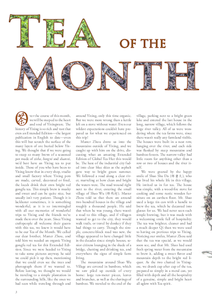 |
|
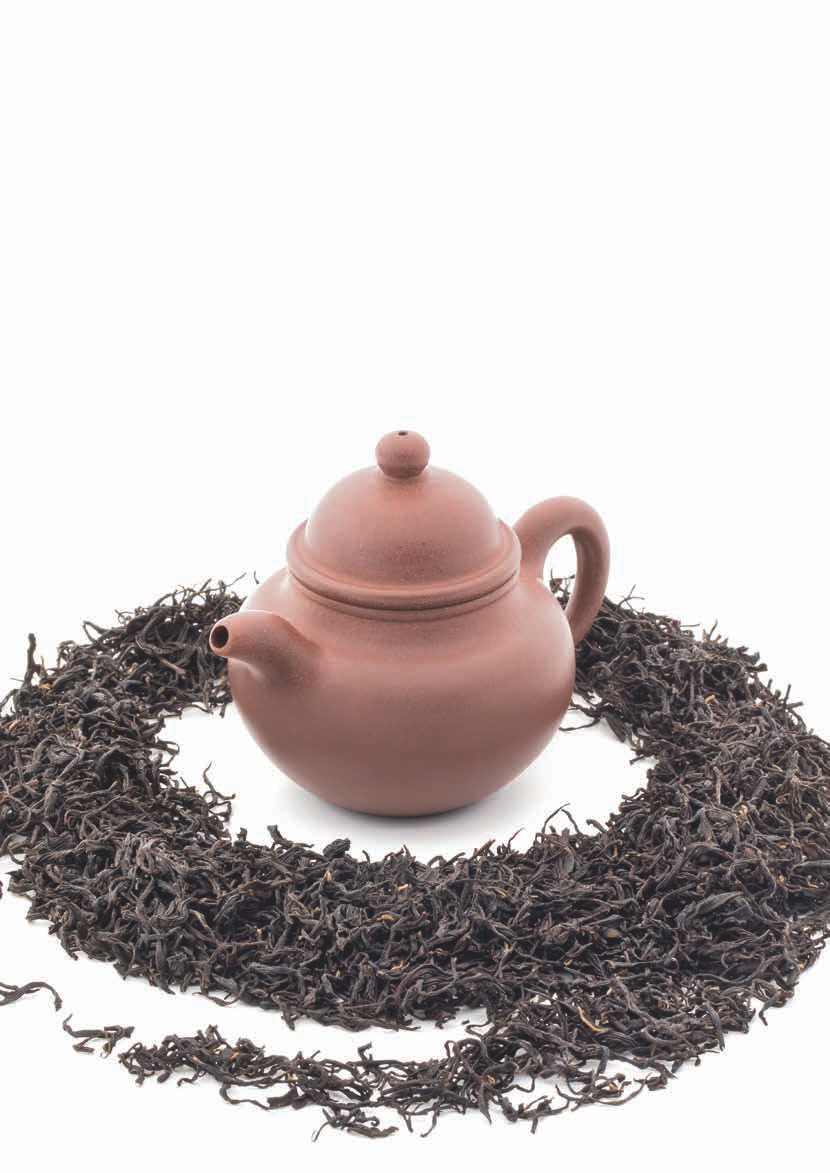
Over the course of this month, we will be steeped to the heart and soul of Yixingware. The history of Yixing is so rich and vast that even an Extended Edition - the largest publication in English to date - even this will but scratch the surface of the many layers of ore buried below Yixing. We thought that if we were going to steep so many brews of a seasoned pot made of zisha, hongni and duanni, we'd best have an Yixing tea to put inside. Those of you who have been to Yixing know that in every shop, studio and small factory where Yixing pots are made, carved, decorated or fired, the locals drink their own bright red gongfu tea. This simple brew is musky and sweet and can be quite nice, but usually isn't very patient. Though it is lackluster sometimes, it is something wonderful, as it is so intermingled with all our memories of wonderful trips to Yixing and the friends we've made there over the years. Since Yixing craftspeople all welcome their guests with this tea, we knew it would have to be our Tea of the Month. We called our dear brother, Master Zhou, and told him we needed an organic Yixing gongfu red tea for this Extended Edition. Since we were headed to Yixing to take some pictures anyway, he said we could pick it up then, mentioning that we could even see the trees and photograph them if we wanted to. Before leaving, we thought we would be traveling to a simple plantation in the surrounding hills, like the ones we had seen while traveling through and around Yixing, only this time organic. But we were more wrong than a kettle left on a stove without water: Even our wildest expectations couldn't have prepared us for what we experienced on this trip!
Master Zhou drove us into the mountains outside of Yixing, and we caught up with him on the drive, discussing what an amazing Extended Edition of Global Tea Hut this would be. The haze of the industrial city faded into clear blue skies as the asphalt gave way to bright green summer. We followed a road along a clear river, marveling at how clean and bright the waters were. The road wound right next to the river, entering the small village of Shao Wu (邵塢村). Master Zhou told us that there are around two hundred houses in the village and roughly a thousand people. He said that when he was young, there wasn't a road to this village, and if villagers wanted to get to the city, they would walk trails, or travel by donkey if they had things to carry. Though the simple, concrete-block road was new, the village appeared to have changed little in the decades since: simple houses, senior citizens lounging in the shade of a bridge, chatting and drinking tea, and everywhere the signs of simple farm living.
The mountains around Shao Wu Village are covered in bamboo, which we saw piled up outside of every home: large ten-meter pieces, leaves and branches, as well as the shavings of bamboo. We traveled to the end of the village, parking next to a bright green lake and entered the last house in the long, narrow village, which follows the large river valley. All of us were wondering where the tea farms were, since there wasn't really any farmland visible. The houses were built in a neat row, hanging over the river, and each side was flanked by steep mountains and bamboo forests. The narrow valley had little room for anything other than a row or two of houses and the river itself.
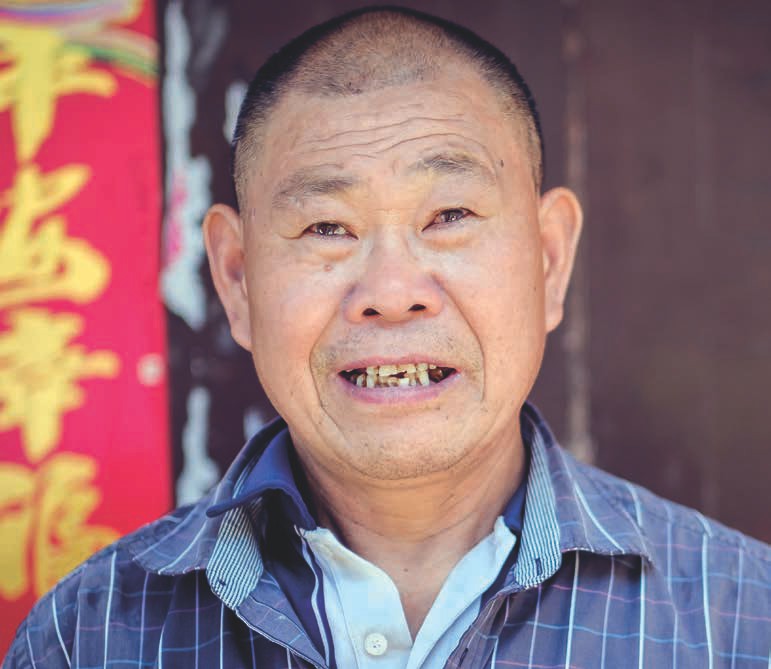
We were greeted by the happy smile of Shao Shu Da (邵書大), who has lived his whole life in this village. He invited us in for tea. The house was simple, with a wood-fire stove for cooking and some rustic wooden furniture on an earthen floor. Mr. Shao used a large tin can with a handle to brew the tea, which he decanted into glasses for us. We had never seen such simple brewing, but it was made with a welcoming smile full of hospitality. The tea was brighter, cleaner and had a much deeper Qi than we were used to having on previous trips to Yixing. Noticing our smiles, Master Zhou said that the tea was special, as we would soon see, and that Mr. Shao had used fresh spring water from the mountains to brew it, adding a sweet flavor and mountain depth to the bright red liquor. As the two chatted in Yixingese, we drank cup after cup of the tea, prepared so simply in a metal can, yet filled with depth and all the hospitality of a genuine, simple and bright heart all aglow with Tea spirit.
It turns out that Mr. Shao, who is sixty-five years old, is actually Master Zhou's father's cousin, so Master Zhou calls him "uncle." After they chatted for a while and we contentedly drank the beautiful tea, Master Zhou helped us translate Mr. Shao's Yixingese into Chinese so we could talk, as he speaks little Mandarin and with a thick accent. He has been farming tea for fifty years, as his father also made red and green tea here. But "farming" may not be the right word, which was the surprise Master Zhou had been keeping something from us. It turns out the villagers here still to this day make more than ninety percent of their income from foraging in the mountains. The forests are primarily bamboo, which they use to build furniture, construct buildings, make brooms out of the branches and leaves and sell dried bamboo shoots for food. Mr. Shao said that almost all the vegetables they eat are also foraged in the nearby hills. When we asked if we could see his tea farm, he laughed and gestured to the mountains all around, saying, "You are looking at it!"
All of the tea in this village is also foraged wild from the forests all around. They have no tea fields. Mr. Shao thinks that tea has been here since the early Qing Dynasty (1644 - 1911). He thinks that villagers had gardens back in the day, but that they spread wild into the hills, long before even his father was born. He said he never met his grandfather, but that his father told him that when he had been a boy, they had also foraged wild tea. They forage enough to drink and share with guests, and when someone from the city orders some green or red tea from them, they also make some to earn some extra cash. Otherwise, they are foraging food or bamboo most days to make a living. Mr. Shao said that most people would rather buy tea from the plantations in the hills below, as wild tea isn't as sweet. We thought maybe the wild tea would be more expensive, as it is in most places in the world, and deter some buyers, but it turns out that their tea is cheaper than the inorganic plantation tea grown at lower altitudes. Mr. Shao said that the villagers' attitude was that the mountain provides for them and the tea was all a free gift. They don't have to pay for the land, don't have any taxes or expenses, and this is reflected in the cheaper prices. As we drank tea and talked, we started to see this village in a new light. When we stepped outside to take a small walk, we did so with a great respect for these people and a life lived in harmony with Nature. They obviously weren't taking too much or polluting the environment, as the whole valley and surrounding mountains were thriving with life. We could hear the cicadas and birdsong even from inside Mr. Shao's house.
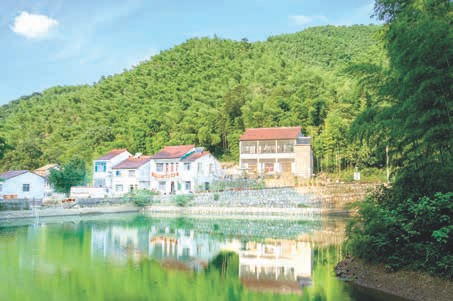

We chatted with Mr. Shao for a while about foraging (using Master Zhou as a translator). We asked him about whether he felt resources were dwindling. He said that the forest was still abundant enough for the village, saying that the families here all lead simple lives and know what is enough. Mr. Shao only goes to the city once every two years, saying that the mountains provide everything he needs to live a happy, healthy life. When we asked about the harvest of tea, and if the villagers argued since the tea trees don't belong to anyone, he said that there are plenty of wild "gardens" to go around, and that they never overharvest so the trees can grow strong and provide next year's tea as well. We all need to learn to harvest from Nature in a way that accounts for the future. Such plucking not only doesn't harm the environment, it helps the tea trees, which grow and thrive from the pruning. Studies have shown that by harvesting only just enough of wild plants, aboriginal peoples benefit the plant populations they harvest from in reciprocity - often providing gaps in the plant colony that allow for new buds to thrive. Mr. Shao agreed, saying that the harvest of bamboo created a more abundant and healthy bamboo forest, like shaving a beard that grows back thicker as a result. Humanity does have a place and a role in Nature; we just need to work together in cooperation the way that other species do, taking and giving in a balance that creates healthy, thriving ecologies that sustain themselves. 6
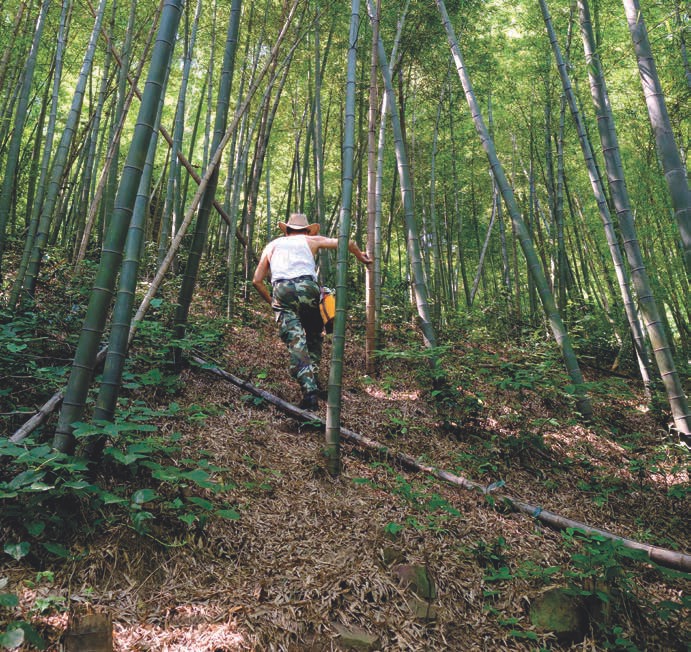
We walked just a bit into the forest, happy to be in the shade of the bamboo, which was a few degrees cooler. Mr. Shao said that when he was young there were tigers, bears and even the occasional panda in these forests, but that the villagers hadn't seen any in quite some time. We arranged a time to hike up into the mountains to see the tea the following morning and headed back into the village amongst a line of other villagers returning home with bamboo. We stopped at another house and were welcomed with the same open smiles and simple red tea in glasses. This is the kind of small place where everyone knows everything happening everywhere, so by now this house and the neighbors, who also stopped in, all knew that foreigners had come to their village, which was exciting for the children who wanted their picture taken with us.
The following morning we drove back to the village bright and early to beat the midday sun. Mr. Shao packed a knife into a wooden holster he wore on his back and led the way into the forest. This, he said, was to clear a path through the dense forest. It was to be that kind of hike! We walked along the river for a few minutes, and then turned up a crude staircase that looked like the bed of a river: loosely organized stones that resembled steps, with water flowing around them here and there. Mr. Shao said that when it rains heavily, this path does, in fact, become a river, but the stones were placed here by him, his son and some neighbors to make access to this part of the forest much easier. He said the stones make hiking easier and keep the path clear. We hiked up these steps for around two kilometers, growing more and more respectful of Mr. Shao with each step. Gathering this tea is hard work. Mr. Shao told us that the wives pick the tea and the men carry it down and process it, saying that "tea picked by women is better" in a tone that suggested this was something everyone knows. We couldn't imagine carrying forty to eighty kilograms of tea down this steep slope. It was hard work hiking up with a backpack full of a camera and some lenses!
After about an hour, including a couple of rest stops to drink some water, the stone path ended in forest. Up here, there were some trees growing sporadically around the bamboo, though the forest was entirely bamboo on the way up - bamboo, insects and birds. The slope was also much steeper here, so we had to use the bamboo to pull ourselves up, finding footholds that allowed us to grab the next one and pull. Before doing so, we said a small prayer of thanks to the bamboo, asking them to keep us safe and for permission to lean on them on the way up. After a few slow minutes of pulling ourselves up the steep slope one bamboo at a time, Mr. Shao stopped and looked around proudly and said, "We're here. This is one of the tea gardens we harvest."

It took a moment for our eyes to adjust to the shaded, thick forest, but then they started to glow in our hearts: tea trees! Scattered all around the bamboo, thickets and other trees were beautiful wild Camellias. They don't grow up very tall here because there is insufficient light. We realized that the sweetness in the tea Mr. Shao had served us the day before was in part due to this lack of sunlight, causing the trees to produce fewer tannins and less astringency. We disagreed with the city folk whom he said found the plantation tea grown below to be sweeter. The tallest tree was around a meter, but most were about half that. Despite their small size, they were all thriving: green and bright, with thick trunks and no dead or dried up leaves. There were also many new, baby tea trees growing nearby. After saying some prayers, we asked to take some bigger leaves. We were here too late to harvest the buds in the tea we are sending you this month, but we wanted to process a little bit ourselves and didn't mind some bigger, thinner and more bitter leaves, as we were making the tea just for the experience. Mr. Shao said that the tea we are sending you was picked from this and other gardens in April, and had many more buds and small leaves inside. He said they usually pick a bud and three leaves each time.
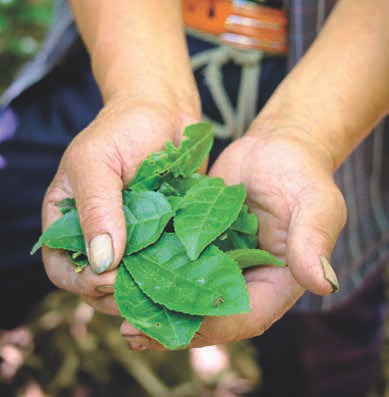
Though there certainly were bug bites in the leaves of the tea trees, they weren't decimated, and there was a tremendous amount of insects all around us. We had all as much as bathed in essential oils before beginning our hike, and you could hear the cacophony all around you, whether you listened or not. This proves that insects really prefer eating other plants due to the bitterness of tea, and therefore won't destroy tea in a thriving and full ecology with biodiversity. Mr. Shao told us that our Tea of the Month has come from three or four such natural "gardens," which are really just clusters of a few hundred wild trees, and that the amount we ordered represents three or four days of picking and processing as well. This is amongst the most labor-intensive teas we've come across, and all tea production is hard work!
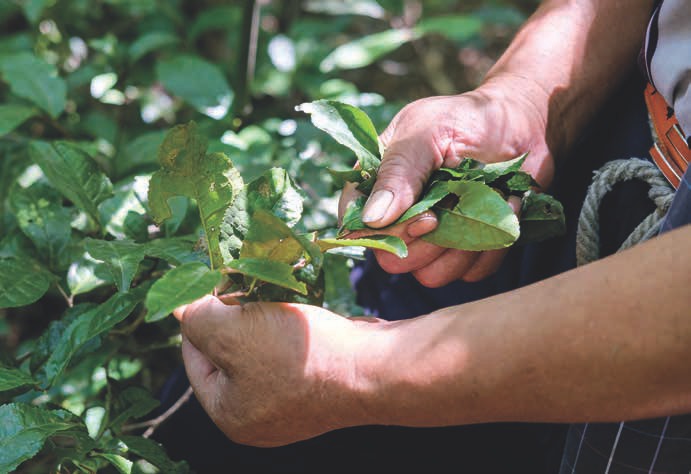
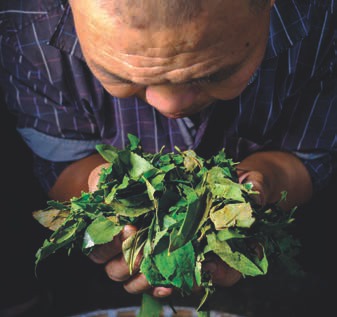


It was exhilarating to spend the morning in such glorious surroundings, with clean air, beautiful bamboo, Nature all around, and, of course, to see wild tea thriving in an unexpected way. From the city below, you would never expect to find the surrounding mountains so full of wild tea, let alone be foraging wild tea here a day after you arrived. All of us were beaming! This is how tea should be grown everywhere - pure, natural, living tea. This tea is naturally seed-propagated. Seeds are carried by mice and buried, some of which don't survive the winter and, therefore, don't ever eat them, allowing them to sprout. The trees don't grow tall, due to limited sunlight, but have plenty of room. More importantly, they have deep roots, which Mr. Shao said extend down several meters. These leaves are born from the womb of this rich environment, full of nutrients and life - insects, animals and birds, clear, clean water and deep quiet. And maybe it is just the suggestion of having spent the day in the forest, but we swear we can taste the bamboo in this tea in every sip. Can you?
Mr. Shao was proud, and brought out some melons from his pack to share, which cooled us all off for the hike back down. We looked around and this month's tea felt like it was destined to be named "Morning Glory." After our refreshing melons, we finished picking a small bag of tea leaves while Mr. Shao cleared some parasitic vines from some of the tea trees with care and found some fallen bamboo to make us hiking sticks for the way down. After a few meters, we realized that we never would have made it back down without these sticks, using one hand on the stick, taking a step and then grabbing a bamboo with the other hand. We went back down to the stone steps sideways so as not to slip and fall down; it was that steep! Believe us, there is a lot of hard work in this month's tea. Fill your cups with respect for the farmers who foraged these mountains.
After the long hike down, and a few minutes to rest our sore legs, Mr. Shao showed us the simple processing of this tea, which is like dian hong. First, the tea is withered outdoors, for around an hour, depending on the sun (shai qing, 曬青). This is to evaporate moisture in the leaves, making them limp for processing. When they are plucked, they are too brittle to work with. Also, this process begins the oxidation in the leaves. Then, the tea comes inside for rolling. Mr. Shao said that since we were only making a small amount of tea, we would roll it by hand, but that their "bigger batches," like the tea you will be drinking this month, were rolled by machine, uncovering his small rolling machine, which had been tucked in the corner of his house this whole time. The tea is rolled for around two hours, which is longer than some red tea. We think this is probably because the tea leaves are thicker and stronger, since the trees are wild, with deeper, stronger roots. Red tea is rolled to more fully break down the cells and oxidize the tea. After rolling, the tea is oxidized in piles, wrapped up in cloth for four to seven hours, depending on the leaves. Finally, the tea is sun-dried, which also influences the flavor.
The processing of this month's tea is as simple as the mountains it grows in and the lives of the people who forage it. Overall, Mr. Shao and his wife make less than fifty kilograms of tea a year, and we can understand why. The hike up and down the mountain was tiring, and we hardly picked any tea and weren't carrying much other than a camera and some lenses. Mr. Shao told us that around thirty-five kilograms are for some extra income and the rest they keep to drink all throughout the year, saying that in Shao Wu village, you have to have lots of tea on hand, as your neighbors may come over at any time, and it is customary to offer them some tea when they drop by for a chat, usually in the evening after a hard day's work harvesting bamboo and crafting it into goods, or foraging wild vegetables for dinner.
When we told Mr. Shao about Global Tea Hut, he couldn't believe it. He kept repeating the names of some of the countries his tea would travel to, beaming with pride. Master Zhou said that the villagers would be talking about our visit for weeks, and that Mr. Shao would have boasting rights amongst them, though we think he is much too humble to brag.
Technically, red tea from Yixing is a "gongfu red tea," like we discussed in the June issue of this year. This means that it is made from a varietal traditionally used to make green tea, and the selection process is more stringent than with most red teas. Usually, the first flush of buds is reserved for green tea, and later leaves are then made into red tea, like in Huangshan. But gongfu red tea is made of the first flush buds, and often processed with more care and added steps, since the raw material is a higher grade. This typically results in a bright red or golden liquor that is more sweet and musky than most red teas. Though all Yixing red tea is customarily called "gongfu red tea," and is indeed made from green tea varietals, often all-bud or leaf-and-bud sets, and processed with more steps and care, we aren't sure that the tea from Shao Wu Village really fits so neatly into the "gongfu red tea" category. Though it is a varietal that was probably originally planted in these hills to make green tea, it has grown wild for at least a hundred years. The seed-propagation has meant evolution and mutation. Every tree is unique, though they are all squat, dense medium-leaf trees that grow wider than tall, due to the lack of sunlight on the forest floor. And Mr. Shao's processing is the paragon of simplicity, reminding us of the aboriginals in Yunnan who have been making humble dian hong in this way for centuries.
In the end, the hike up a manmade riverbed of stones to a steep slope that we used bamboo to pull ourselves up to a ridge filled with thickets, bamboo, trees and tea, surrounded by birds and insects, running water and wind - all these left us comfortable with the fact that this wild tea defies our mindmade categories. And the hike back down, followed by the rustic and simple processing of the leaves, which were then literally brewed in a large tin cup, put the exclamation point on the "wild!" After such a glorious morning, we were left inspired. This is how tea was produced for centuries, and we hope that the inspiration we felt and the gratitude we shared with Mr. Shao will help promote such tea production elsewhere. There is hope that we can find our place in this world, working for and with Nature, as opposed to against Her!
There is hope, tea family! If you can find wild, foraged tea production just forty minutes outside the industrial, factory-covered outskirts of Yixing, then there's a possibility that such tea is thriving in other remote areas as well. Sometimes it is easy to lose faith in humanity, with all the environmental problems we face, from polluted air to undrinkable water. But then you visit a village like Shao Wu, where people haven't changed their lifeways much in centuries, still surviving by foraging their livelihood from the mountains, and without damaging the environment.
Morning Glory is a testament of a cooperative, harmonious life of people and mountain working together. Seeing pristine mountains here and the simple life a forager left us with a deep respect for Mr. Shao and this tea. Wild tea trees with deep roots, drinking only mineral-rich mountain water and eating natural fertilizers, are always brimming with life. You can feel this if you close your eyes in these densely-forested mountains: the vibration of the cicadas and other insects humming a drone, which resounds just below the rhythm of the water and wind, as well as the piping melodies of the creaking, whooshing bamboo.
The Qi of this tea is bursting, and the lack of sunlight means the leaves are sweeter than the average red tea. Since the hike up the mountain is so rigorous, Mr. Shao and his wife pick more than just buds, though, bringing home a bud and three leaves more often. These older leaves add some strength and bitterness to the liquor as well, meaning it isn't as refined as most "gongfu red tea." But what it lacks in refinement, it makes up for in vitality. The bright red liquor is vibrant, musky and very patient, especially for an Yixing red tea, which are usually spent in just a few steepings. This tea doesn't fit in the gongfu tea category, as the selection and processing are too simple, but it is amongst the most ecologically sound, environmentally friendly living teas we have ever encountered. To find wild-foraged tea made with such hard work and care, with more of an attitude of love for forest than a commercial desire to get ahead, fills this tea with amazing life and depth.
Morning Glory is as bold and brisk as the long hike we took that morning to see the trees. There is a lot of Qi in it, which we find to be invigorating, making it a good tea to drink in the morning. The sun-drying means the tea is crisp and slightly toasty in flavor, and increases the radiance you feel in your chest after a few cups. If you hang on to the later steepings, you will be rewarded with a mineral-rich golden brew that tastes of crystals, rocks and streams, and though the tea loses its musky sweetness as it transforms from bright red to orange to gold, these latter steepings are beautifully smooth and soft.
As we mentioned earlier, we can now taste the bamboo in every sip, especially the early cups. The tea tastes almost like a Liu An that has been wrapped and stored in a bamboo basket, but we can't be sure if this is just the impression left from hiking in that bamboo forest. Please let us know if you can taste the bamboo on the app!
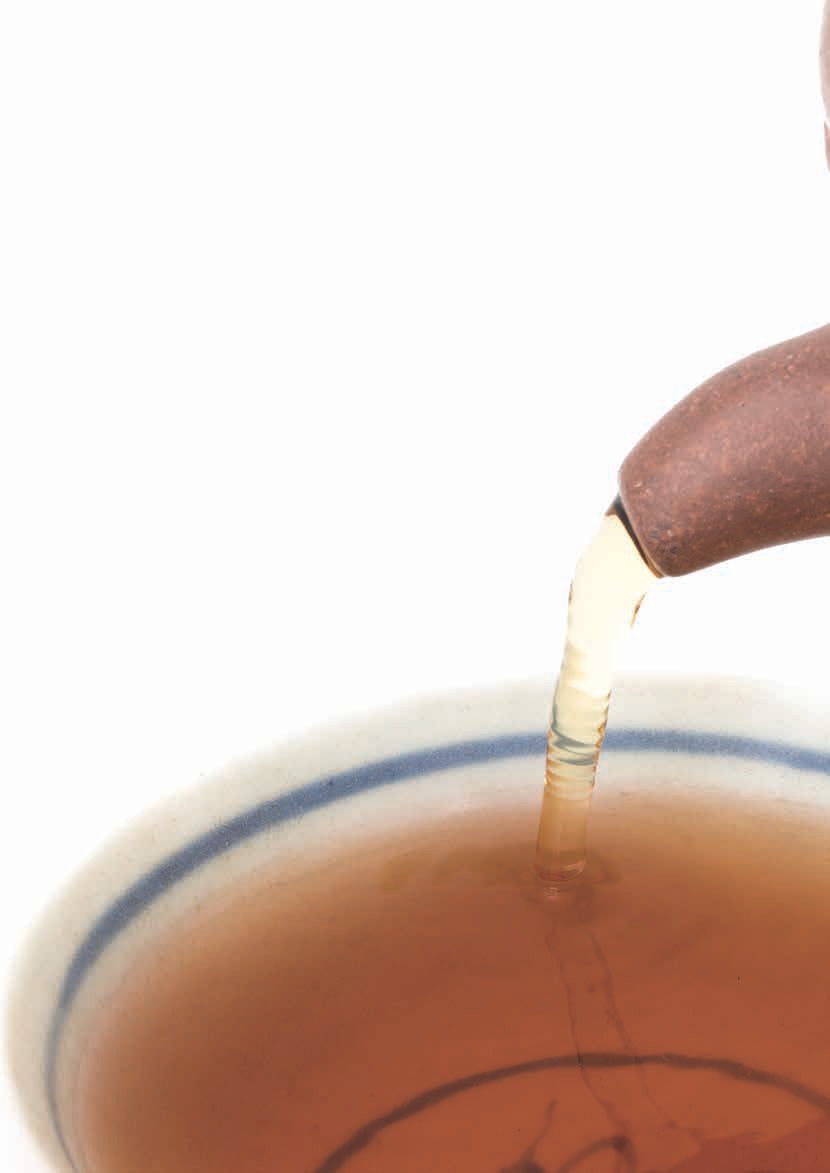
Since this month is all about Yixing teapots, and we're drinking an Yixing "gongfu red tea," we want to suggest that there is no better time to start a gongfu practice than now. If you don't feel ready or aren't prepared to start brewing tea gongfu, this tea can be brewed in a sidehandle and will make quite a nice bowl. It also responds well to being brewed in a large pot, Western style, with long steeping times, as casual kitchen tea (perhaps over a long chat about Yixing history and lore). If you need a pot, you may want to check our website to see if any of our Light Meets Life fundraiser pots are still available.
Gongfu brewing is an art form. "Gongfu" literally means "mastery through self-discipline," in fact. Like any art, mastery is achieved through the heart, not the mind. The mind gets in the way. You have to learn to feel each of the steps and learn them by touch. At some point in the future, we will devote a whole issue to gongfu brewing in our tradition, but for now, we thought we would offer a beginner's list of the basic steps for those of you just getting started. You will need an Yixing pot, cups, a kettle, a waste-water container (jian shui, 建水) and a teaboat (cha chuan, 茶船). There are infinite subtleties to learn as you travel, but here are the steps reduced to a very basic formula (don't get stuck on this as some kind of "how-to," though):
Place the cups in front of the teaboat, with the pot inside and the jian shui on the side of the off-hand, which is also where the kettle should be. Rinse the cups and teapot with hot water, and then add the leaves. Then, rinse off the leaves as well, pouring the rinse water into the jian shui. Shower the pot around the body, not the lid, so it isn't too hot to grab. Then lift the lid and place water in the pot, moving in circles until the water is above the leaves, so as not to scald any one leaf. Leave some space in the pot. Then replace the lid and give the pot a good shower with hot water, this time covering everything. Fill the cups to prewarm them, swishing the hot water and quickly pouring it into the jian shui. After the tea has steeped, scrape the pot on the side of the teaboat to remove any water, and pour in circles around the edges of the cups so you don't make any bubbles. Empty the teaboat and replace the pot, before handing the cups out to your guests. These basic steps are then repeated for each steeping. Practice and refinement, discipline and learning will help you master this process over time, like all aspects of gongfu tea brewing.